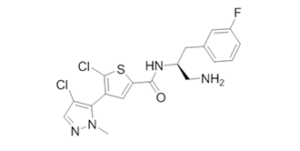Afuresertib (GSK-2110183)
This product is for research use only, not for human use. We do not sell to patients.

For small sizes, please check our retail website as below: www.invivochem.com
| Size | Price | Stock |
|---|---|---|
| 250mg | $779 | Check With Us |
| 500mg | $1170 | Check With Us |
| 1μg | $1755 | Check With Us |
Cat #: V0169 CAS #: 1047644-62-1 Purity ≥ 98%
Description: Afuresertib (also named as GSK2110183C) is a potent, orally bioavailable and ATP-competitive Akt inhibitor with potential anticancer activity.
Top Publications Citing Invivochem Products
Publications Citing InvivoChem Products
Product Promise

- Physicochemical and Storage Information
- Protocol
- Related Biological Data
- Stock Solution Preparation
- Quality Control Documentation
| Molecular Weight (MW) | 427.32 |
|---|---|
| Molecular Formula | C18H17Cl2FN4OS |
| CAS No. | 1047644-62-1 |
| Storage | -20℃ for 3 years in powder formr |
| -80℃ for 2 years in solvent | |
| Solubility In Vitro | DMSO: 85 mg/mL (198.9 mM)r |
| Water: <1 mg/mLr | |
| Ethanol: <1 mg/mL | |
| SMILES Code | O=C(C1=CC(C2=C(Cl)C=NN2C)=C(Cl)S1)N[C@@H](CC3=CC=CC(F)=C3)CN |
| Synonyms | GSK2110183C; Afuresertib free base; GSK2110183; GSK 2110183; GSK-2110183; GSK2110183C; GSK 2110183C; |
| Protocol | In Vitro | Afuresertib (GSK2110183) exhibits favorable tumor-suppressive effects on malignant pleural mesothelioma (MPM) cells. Afuresertib significantly increases caspase-3 and caspase-7 activities and apoptotic cell number among ACC-MESO-4 and MSTO-211H cells. Afuresertib strongly arrests the cell cycle in the G1 phase. Western blotting analysis shows that Afuresertib increases the expression of p21WAF1/CIP1 and decreases the phosphorylation of Akt substrates, including GSK-3β and FOXO family proteins. Afuresertib-induced p21 expression promotes G1 phase arrest by inducing FOXO activity. Afuresertib significantly enhances cisplatin-induced cytotoxicity. Afuresertib modulates the expression E2F1 and MYC, which are associated with fibroblast core serum response. |
|---|---|---|
| In Vivo | Mice bearing BT474 breast tumor xenografts are dosed orally with either vehicle or GSK2110183 at 10, 30 or 100 mg/kg daily for 21 days which result in 8, 37 and 61% TGI, respectively. Mice tolerated GSK2110183 well, with 1-3% body weight loss reported after 5 days of dosing which recover over the course of the study. Other tumor xenograft models which possess an activation of the Akt pathway are explored to further demonstrate compound efficacy. Mice treated with GSK2110183 at 10, 30 and 100 mg/kg result in 23, 37 and 97% TGI, respectively, of SKOV3 xenografts. |
These protocols are for reference only. InvivoChem does not
independently validate these methods.
| Solvent volume to be added | Mass (the weight of a compound) | |||
|---|---|---|---|---|
| Mother liquor concentration | 1mg | 5mg | 10mg | 20mg |
| 1mM | 2.3402 mL | 11.7008 mL | 23.4017 mL | 46.8033 mL |
| 5mM | 0.4680 mL | 2.3402 mL | 4.6803 mL | 9.3607 mL |
| 10mM | 0.2340 mL | 1.1701 mL | 2.3402 mL | 4.6803 mL |
| 20mM | 0.1170 mL | 0.5850 mL | 1.1701 mL | 2.3402 mL |
The molarity calculator equation
Mass(g) = Concentration(mol/L) × Volume(L) × Molecular Weight(g/mol)
Mass
=
Concentration
×
Volume
×
Molecular Weight*
The dilution calculator equation
Concentration(start)
×
Volume(start)
=
Concentration(final)
×
Volume(final)
This equation is commonly abbreviated as: C1 V1 = C2 V2
Concentration(start)
C1
×
Volume(start)
V1
=
Concentration(final)
C2
×
Volume(final)
V2
Step One: Enter information below
Dosage mg/kg
Average weight of animals g
Dosing volume per animal µL
Number of animals
Step Two: Enter the in vivo formulation
%DMSO
+
%
+
%Tween 80
+
%ddH2O
Calculation Results:
Working concentration:
mg/ml;
Method for preparing DMSO master liquid:
mg
drug pre-dissolved in
µL
DMSO(Master liquid concentration
mg/mL)
,Please contact us first if the concentration exceeds the DMSO solubility of the batch of drug.
Method for preparing in vivo formulation:
Take
µL
DMSO master liquid, next add
µL
PEG300, mix and clarify, next add
µL
Tween 80,mix and clarify, next add
µL
ddH2O,mix and clarify.
Note:
- (1) Please be sure that the solution is clear before the addition of next solvent. Dissolution methods like vortex, ultrasound or warming and heat may be used to aid dissolving.
- (2) Be sure to add the solvent(s) in order.




































